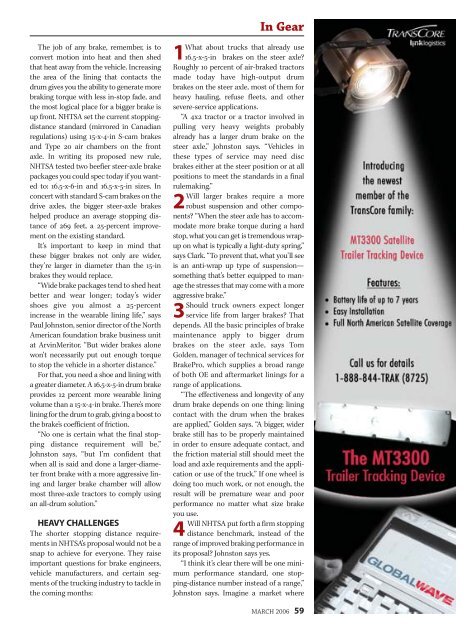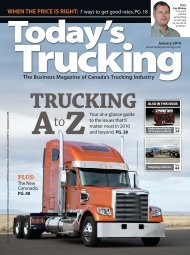Create successful ePaper yourself
Turn your PDF publications into a flip-book with our unique Google optimized e-Paper software.
The job of any brake, remember, is to<br />
convert motion into heat and then shed<br />
that heat away from the vehicle. <strong>In</strong>creasing<br />
the area of the lining that contacts the<br />
drum gives you the ability to generate more<br />
braking torque with less in-stop fade, and<br />
the most logical place for a bigger brake is<br />
up front. NHTSA set the current stoppingdistance<br />
standard (mirrored in Canadian<br />
regulations) using 15-x-4-in S-cam brakes<br />
and Type 20 air chambers on the front<br />
axle. <strong>In</strong> writing its proposed new rule,<br />
NHTSA tested two beefier steer-axle brake<br />
packages you could spec today if you wanted<br />
to: 16.5-x-6-in and 16.5-x-5-in sizes. <strong>In</strong><br />
concert with standard S-cam brakes on the<br />
drive axles, the bigger steer-axle brakes<br />
helped produce an average stopping distance<br />
of 269 feet, a 25-percent improvement<br />
on the existing standard.<br />
It’s important to keep in mind that<br />
these bigger brakes not only are wider,<br />
they’re larger in diameter than the 15-in<br />
brakes they would replace.<br />
“Wide brake packages tend to shed heat<br />
better and wear longer; today’s wider<br />
shoes give you almost a 25-percent<br />
increase in the wearable lining life,” says<br />
Paul Johnston, senior director of the North<br />
American foundation brake business unit<br />
at ArvinMeritor. “But wider brakes alone<br />
won’t necessarily put out enough torque<br />
to stop the vehicle in a shorter distance.”<br />
For that, you need a shoe and lining with<br />
a greater diameter. A 16.5-x-5-in drum brake<br />
provides 12 percent more wearable lining<br />
volume than a 15-x-4-in brake. There’s more<br />
lining for the drum to grab, giving a boost to<br />
the brake’s coefficient of friction.<br />
“No one is certain what the final stopping<br />
distance requirement will be,”<br />
Johnston says, “but I’m confident that<br />
when all is said and done a larger-diameter<br />
front brake with a more aggressive lining<br />
and larger brake chamber will allow<br />
most three-axle tractors to comply using<br />
an all-drum solution.”<br />
HEAVY CHALLENGES<br />
The shorter stopping distance requirements<br />
in NHTSA’s proposal would not be a<br />
snap to achieve for everyone. They raise<br />
important questions for brake engineers,<br />
vehicle manufacturers, and certain segments<br />
of the trucking industry to tackle in<br />
the coming months:<br />
<strong>In</strong> <strong>Gear</strong><br />
1What about trucks that already use<br />
16.5-x-5-in brakes on the steer axle?<br />
Roughly 10 percent of air-braked tractors<br />
made today have high-output drum<br />
brakes on the steer axle, most of them for<br />
heavy hauling, refuse fleets, and other<br />
severe-service applications.<br />
“A 4x2 tractor or a tractor involved in<br />
pulling very heavy weights probably<br />
already has a larger drum brake on the<br />
steer axle,” Johnston says. “Vehicles in<br />
these types of service may need disc<br />
brakes either at the steer position or at all<br />
positions to meet the standards in a final<br />
rulemaking.”<br />
2Will larger brakes require a more<br />
robust suspension and other components?<br />
“When the steer axle has to accommodate<br />
more brake torque during a hard<br />
stop, what you can get is tremendous wrapup<br />
on what is typically a light-duty spring,”<br />
says Clark. “To prevent that, what you’ll see<br />
is an anti-wrap up type of suspension—<br />
something that’s better equipped to manage<br />
the stresses that may come with a more<br />
aggressive brake.”<br />
3Should truck owners expect longer<br />
service life from larger brakes? That<br />
depends. All the basic principles of brake<br />
maintenance apply to bigger drum<br />
brakes on the steer axle, says Tom<br />
Golden, manager of technical services for<br />
BrakePro, which supplies a broad range<br />
of both OE and aftermarket linings for a<br />
range of applications.<br />
“The effectiveness and longevity of any<br />
drum brake depends on one thing: lining<br />
contact with the drum when the brakes<br />
are applied,” Golden says. “A bigger, wider<br />
brake still has to be properly maintained<br />
in order to ensure adequate contact, and<br />
the friction material still should meet the<br />
load and axle requirements and the application<br />
or use of the truck.” If one wheel is<br />
doing too much work, or not enough, the<br />
result will be premature wear and poor<br />
performance no matter what size brake<br />
you use.<br />
4Will NHTSA put forth a firm stopping<br />
distance benchmark, instead of the<br />
range of improved braking performance in<br />
its proposal? Johnston says yes.<br />
“I think it’s clear there will be one minimum<br />
performance standard, one stopping-distance<br />
number instead of a range,”<br />
Johnston says. Imagine a market where<br />
MARCH 2006 59



